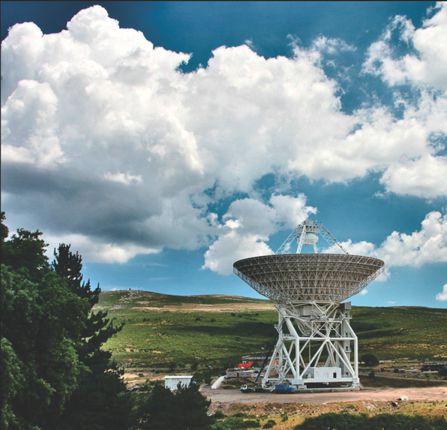New radio telescope eyes sky from Sardinia
DOI: 10.1063/PT.3.1214
Scientists are set to begin debugging the 64-meter Sardinia Radio Telescope (SRT) in southern Italy and plan to make the first observations later this year.
The 500-ton dish was raised in one piece and placed on its 34-meter-tall platform last year (see videos at http://www.srt.inaf.it/multim/videos
The SRT will be used in conjunction with interferometers such as the EVN—the European Very Long Baseline Interferometry (VLBI) Network. After the 100-meter dish in Effenberg, Germany, the SRT will be the second-largest dish in the network, which links 8 to 13 radio telescopes, depending on frequency. The SRT’s initial sensitivity range is 0.3–22 GHz, with a planned stepwise increase to around 100 GHz. The dish’s 1008 electromechanical actuators, which compensate for gravitational deformations, are especially important at higher frequencies. Says Huib van Langevelde, director of the Joint Institute for VLBI in Europe, “Such a large telescope that goes to 3 millimeters [100 GHz] is a major addition to the EVN.” For example, he says, in Europe “we don’t have the sensitivity to probe molecular transitions that produce short-wavelength maser emissions. That will be possible with the SRT.” The telescope will also work with other interferometers, including the US’s Very Long Baseline Array. On its own, the SRT will be used to study pulsars, masers, and other radio sources; identify targets for the interferometers; and track spacecraft missions.
The €60 million ($87 million) tab for the SRT was paid by local and national governments and by the Italian Space Agency (ASI), which has a 20% share in the telescope. The Italian economy has taken a nosedive since construction began in 2003, and D’Amico is concerned about coming up with €3 million for annual operations. Despite radio astronomers having to deal with interference from transmissions in the ASI satellite-tracking applications, D’Amico says that with money tight, “we are happy that ASI is involved.” Given the austere policies introduced into Italy’s public sector (see PHYSICS TODAY, December 2008, page 31

The Sardinia Radio Telescope will start collecting data this year.
INAF—OSSERVATORIO ASTRONOMICO DI CALIGARI

More about the Authors
Toni Feder. tfeder@aip.org
